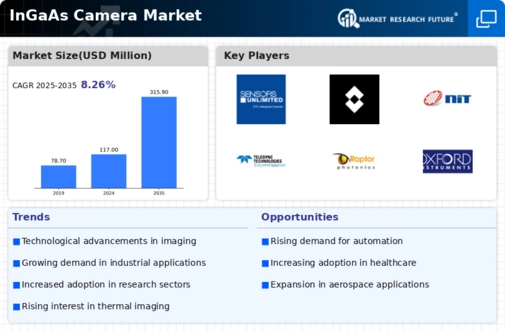Market Share
InGaAs Camera Market Share Analysis
Unveiling the Potential: Demand and Share Analysis of the InGaAs Camera Market The InGaAs camera market presents a compelling case study in cutting-edge technology, offering unique capabilities beyond the reach of standard silicon cameras. Fueled by diverse applications and a growing demand for high-performance imaging solutions, this market is poised for significant growth.
Demand Drivers:
Night Vision and Low-Light Imaging: InGaAs cameras excel in capturing clear images in low-light conditions where conventional cameras struggle. This capability has applications in security and surveillance, industrial automation, and scientific research. Spectral Imaging and Material Analysis: InGaAs cameras are sensitive to near-infrared (NIR) and short-wave infrared (SWIR) wavelengths, enabling them to detect and analyze materials based on their spectral signatures. This finds applications in food inspection, pharmaceutical manufacturing, and environmental monitoring. Medical Imaging and Life Sciences: InGaAs cameras are used in medical diagnostics and research due to their ability to visualize blood flow and oxygen levels in tissues, aiding in the diagnosis and treatment of diseases. Autonomous Vehicles and Robotics: With their superior night vision and ability to perceive depth information, InGaAs cameras are increasingly being incorporated into autonomous vehicles and robots for enhanced navigation and obstacle detection. Market Share Dynamics:
Regional Landscape: North America currently holds the largest share of the InGaAs camera market, driven by significant investments in defense and security, followed by Europe and Asia Pacific. The latter is expected to witness the fastest growth due to its rapidly developing technology sector and growing awareness of the benefits of InGaAs imaging. Industry Segmentation: The market is segmented by application, with security and surveillance accounting for the largest share. However, industrial automation and medical imaging are expected to exhibit strong growth, driven by automation trends and rising healthcare expenditure, respectively. Technology Advancements: Ongoing advancements in sensor technology are leading to the development of smaller, more cost-effective InGaAs cameras, making them accessible to a wider range of applications and users. This is expected to drive further market penetration. Challenges and Opportunities:
High Cost: Currently, InGaAs cameras are significantly more expensive than silicon cameras, limiting their adoption by cost-sensitive industries. Technological advancements and economies of scale are expected to address this challenge over time. Limited Awareness: Awareness about the capabilities and benefits of InGaAs cameras remains limited compared to conventional cameras. Educational initiatives and demonstrations of real-world applications are crucial to expand market awareness. Standardization: The lack of industry-wide standards for InGaAs cameras presents challenges in terms of interoperability and compatibility. Establishing common standards will facilitate easier integration and adoption of this technology. Future Outlook:
The InGaAs camera market presents a compelling opportunity for growth, driven by its unique capabilities and diverse applications. Addressing the existing challenges through technological advancements, education, and standardization will be crucial to unlocking the full potential of this market. Players who can offer innovative solutions, address specific needs across diverse industries, and navigate the evolving market landscape are poised to capture significant market share and drive the future of InGaAs imaging technology.









Leave a Comment